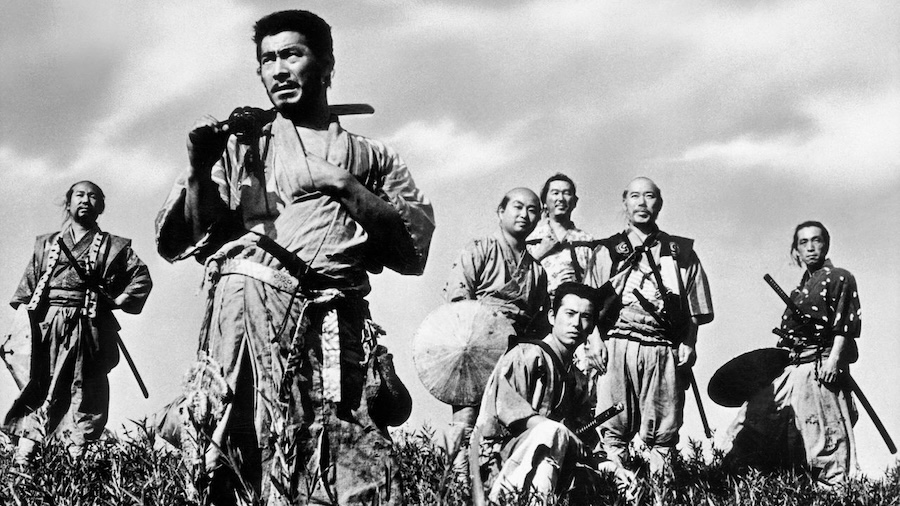
UNMATCHED FOR SUSPENSE AND SPECTACLE!

I saw this, the most famous of Akira Kurosawa’s movies, for the first time twenty years ago while studying journalism. More than three hours long, Seven Samurai is a challenging experience. I find it amusing to note that at the time of its international premiere, Toho Studios feared that Americans would not want to sit through a foreign-language epic of this size and cut 50 minutes – and still, the film became a sensation. Today, the full 208-minute version is the most commonly available… but perhaps it says something about the movie that no one seemed to miss those 50 minutes back in the 1950s.
An attack is imminent
In 1586, bandits wield considerable power in the countryside. When the people of a village learn that a group of bandits are planning to attack them after the harvest, they ask the village elder for advice. He tells them to find and hire samurai to protect the village; he knows that it’s been successful in other villages. A scouting party heads out to find suitable samurai and talks to Kambei Shimada (Takashi Shimura). He’s an older ronin who impresses the men in the scouting party by rescuing a child in a hostage situation. Kambei has doubts, but agrees to help them find six additional samurai, more than the village elder requested, but that’s what he considers will take to defeat the bandits.
In the end, it’s a motley bunch of warriors, including Kikuchiyo (Toshiro Mifune), who’s a bit of a wild card, carrying around a family scroll that ”proves” he’s a samurai.
Black and white blend into gray
Kurosawa had already made his first masterpiece, Rashomon (1950), but Seven Samurai became an even greater cultural phenomenon, the film that truly introduced samurai warriors to a Western audience. The concept is simple but the director almost trips over himself, devoting a lot of time to the villagers gathering the samurai and depicting how the warriors interact with the villagers. On the other hand, the running time and Kurosawa’s ambitions provide a chance to bring greater depth to the seven and how they differ from the villagers. A movie about bandits attacking and warriors defending may look very black and white, but Seven Samurai blends those colors into gray.
Takashi Shimura is solid as the leader of the group, while Toshiro Mifune is wildly entertaining as a prankster with a complicated past.
There’s time to make sure the seven men are portrayed as separate individuals (there’s even a romance between one of the younger samurai and a woman in the village) and the film chronicles their paths with strokes of darkness. The last scene is one of the most memorable, where Kambei makes a poignant comparison between the villagers and his unfortunate fellow warriors, following an elaborate battle between them and the bandits. That last third of the movie is intense, filmed with several cameras, which was not common at the time; Kurosawa wanted a lot of footage to choose from in the editing process, including shots from a camera crew working as a kind of ”guerrilla unit”. Shimura is solid as the leader of the group, while Mifune is wildly entertaining as a prankster with a complicated past; his character was considered necessary as a counterweight to the other six.
An overlong spectacle, but also an important classic with many memorable ingredients, including Fumio Hayasaki’s score that expertly fused traditional Japanese music with Western symphonic traditions.
Seven Samurai 1954-Japan. 208 min. B/W. Directed by Akira Kurosawa. Screenplay: Akira Kurosawa, Shinobu Hashimoto, Hideo Oguni. Music: Fumio Hayasaki. Art Direction: Takashi Matsuyama. Costume Design: Kohei Ezaki. Cast: Toshiro Mifune (Kikuchiyo), Takashi Shimura (Kambei Shimada), Yoshio Inaba (Gorobei Katayama), Ko Kimura, Seiji Miyaguchi, Minoru Chiaki.
Trivia: Original title: Shichinin no samurai. Remade several times in different countries, most memorably in the U.S. as The Magnificent Seven in 1960 and 2016.
Venice: Silver Lion.
Last word: “The samurai were preoccupied with themselves, not so much with helping the peasants out of compassion. Kikuchiyo, played by Mifune, was the ideal go-between – the samurai brought up among peasants. As time went on, both sides, samurai and peasants, had come down to the very basic human condition where they had to fight together to fend off an enemy. Do you remember the battles in the hard rain? Everybody had to fight for himself. They all melted into the same class.” (Kurosawa, “Akira Kurosawa: Interviews”)
